112/3/D5
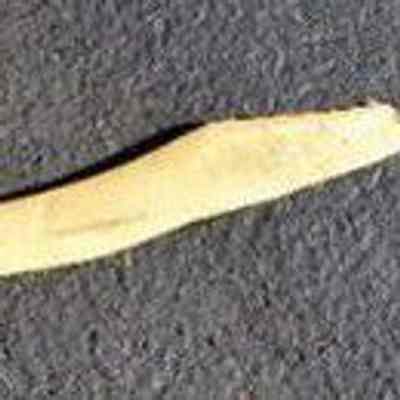

Ax Handle
Name/Title
Ax Handle
Description
Wooden handle
Use
Felling and splitting wood
Acquisition
Source (if not Accessioned)
Abenaki Cultural Conservancy
Made/Created
Date made
circa 1970
Materials
Material
Ash
Entry/Object ID
L2024.3.156
Context
The axe handle snowshoe frames (L2024.3.157a-b) descended in a Missisquoi Abenaki family from Fonda Junction.
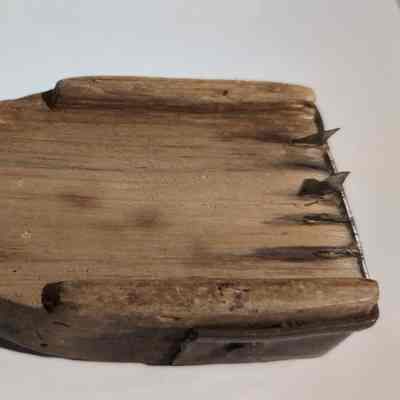

Basket Gauge
Name/Title
Basket Gauge
Description
Wooden hand-tool with carved shoulders and teeth.
Use
Stripping ash splints to a specific size
Acquisition
Source (if not Accessioned)
Abenaki Cultural Conservancy
Ethnography
Made/Created
Date made
1880-1900
Materials
Material
White Pine
Entry/Object ID
L2024.3.149
Context
This white pine basket gauge is from a Troy, Vermont family of Indian basket makers, almost certainly Abenaki, although this was not stipulated by the seller. It is almost identical in construction to Odanak and Penobscot gauges in the collection.
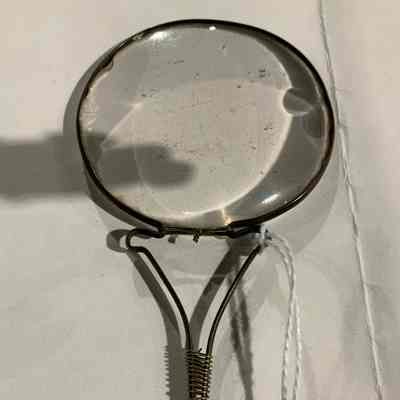

Burning Glass
Name/Title
Burning Glass
Use
Used in SW Maine
Acquisition
Source (if not Accessioned)
Abenaki Cultural Conservancy
Made/Created
Date made
circa 1750
Materials
Material
Glass, Steel, Copper
Entry/Object ID
L2024.3.35
Context
These were widely traded to native peoples as fire starters, it is not known whether they were used by the Abenakis, but it comes from the upper Connecticut River.
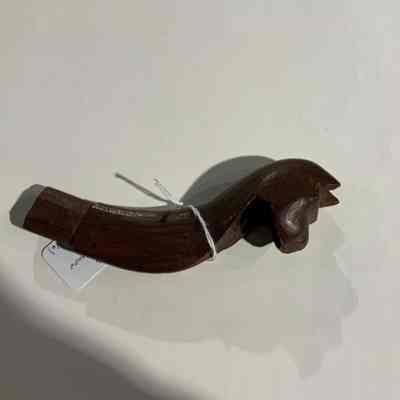

Crooked Knife
Name/Title
Crooked Knife
Description
Handle for knife
Acquisition
Source (if not Accessioned)
Abenaki Cultural Conservancy
Made/Created
Date made
circa 1930
Entry/Object ID
L2024.3.16
Context
Handle only
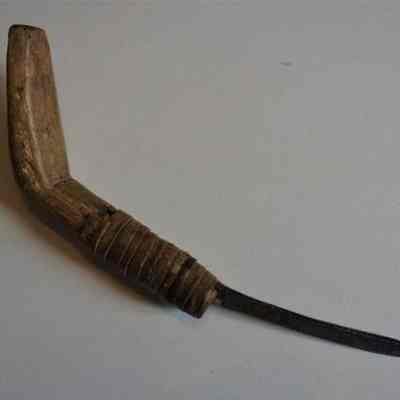

Crooked Knife
Name/Title
Crooked Knife
Description
Steel blade attached to "crooked" wooden handle and bound with rawhide.
Use
Snowshoe making
Acquisition
Source (if not Accessioned)
Abenaki Cultural Conservancy
Ethnography
Made/Created
Date made
circa 1880
Materials
Material
Wood, Steel, Rawhide
Entry/Object ID
L2024.3.151
Context
This mid-late 19th century crooked knife is the only one Wiseman has seen in the Abenaki area with a rawhide-wrapped handle. The handle is of softwood. Other than that, it is a typical example of a native-made tool used for making basket handles, snowshoes, axe handles and many other items.
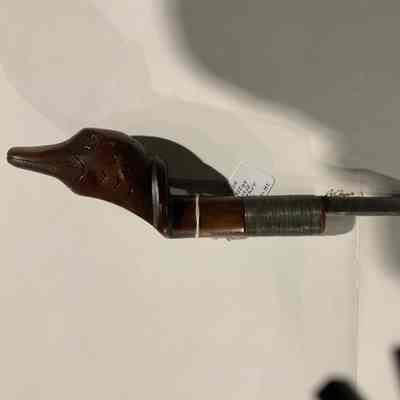

Crooked Knife
Name/Title
Crooked Knife
Description
Crooked Knife with duck carving
Acquisition
Source (if not Accessioned)
Abenaki Cultural Conservancy
Made/Created
Date made
circa 1930
Entry/Object ID
L2024.3.14
Context
Duck effigy crooked knife
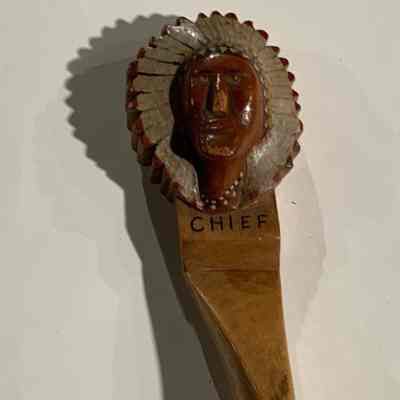

Crooked Knife
Name/Title
Crooked Knife
Description
Crooked Knife with sheath. Image of 1910 "Chief."
Acquisition
Source (if not Accessioned)
Abenaki Cultural Conservancy
Made/Created
Date made
1910
Entry/Object ID
L2024.3.44a-b
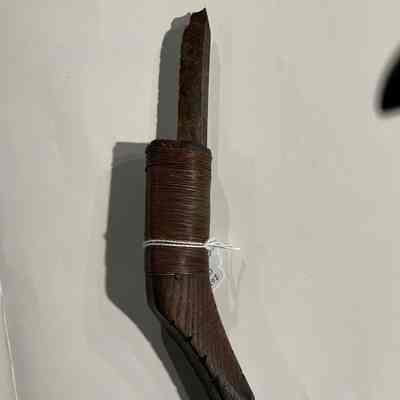

Crooked Knife
Name/Title
Crooked Knife
Description
Crooked knife
Acquisition
Source (if not Accessioned)
Abenaki Cultural Conservancy
Made/Created
Date made
1900
Entry/Object ID
L2024.3.15
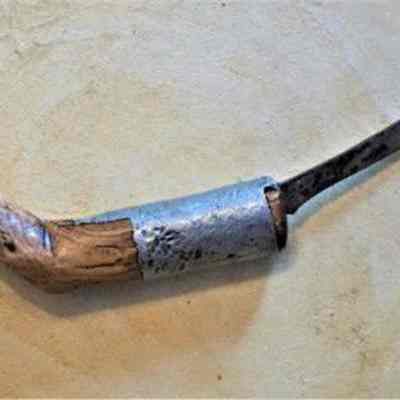

Crooked Knife
Name/Title
Crooked Knife
Description
Steel blade affixed to "crooked" wood handle with pewter fastener
Use
Basket maker
Acquisition
Source (if not Accessioned)
Abenaki Cultural Conservancy
Ethnography
Made/Created
Date made
1880-1920
Materials
Material
Wood, Steel, Pewter
Entry/Object ID
L2024.3.147
Context
This item is unique in American Abenaki crooked knives in that the blade is held to the crooked wood handle by a cast pewter bolster.
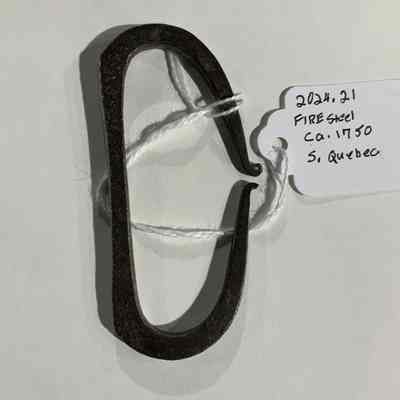

Fire Steel
Name/Title
Fire Steel
Use
For striking with flint to create spark
Acquisition
Source (if not Accessioned)
Abenaki Cultural Conservancy
Made/Created
Date made
circa 1750
Entry/Object ID
L2024.3.21
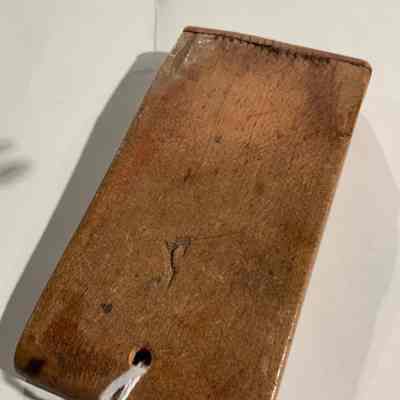

Splint Gauge
Name/Title
Splint Gauge
Description
Small wooden board with sharp metal teeth inserted at regular lengths atop on end. Teeth point outward from long side of board. End-grain where teeth are located is capped with a small strip of wood. Small hole drilled in opposite end of board from teeth.
Use
Gauge used to measure and mark ash splints for basket making
Acquisition
Source (if not Accessioned)
Abenaki Cultural Conservancy
Made/Created
Date made
circa 1900
Entry/Object ID
L2024.3.46
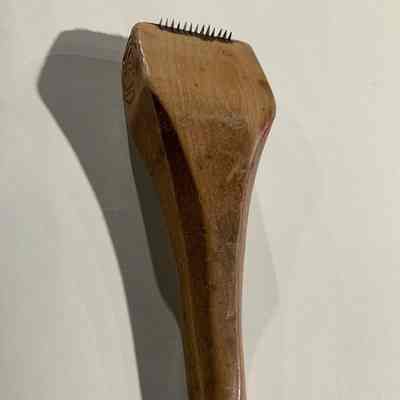

Splint Gauge
Name/Title
Splint Gauge
Description
Shaped wooden form, square at end and tapering to a round handle at the other. Square end has twelve, small metal teeth embedded in the face of the form. The sides of the square end have low-relied floral carvings, probably depicting roses. The flat portion of the square end, opposite the teeth, has a low-relief (or chip) carving of a rose on stem with leaves. The stem descends part-way down the handle. Chip-carved, geometric forms are found on either side of the shoulder.
Use
Gauge used for measuring and marking ash splints for basket making
Acquisition
Source (if not Accessioned)
Abenaki Cultural Conservancy
Made/Created
Date made
circa 1900
Entry/Object ID
L2024.3.47
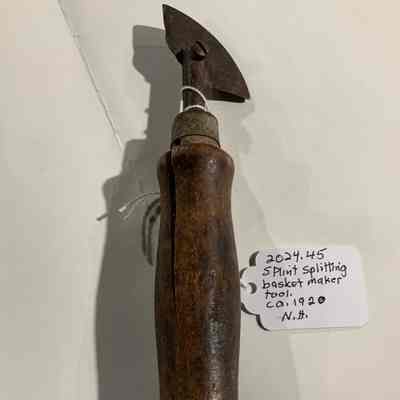

Splint Splitting Tool
Name/Title
Splint Splitting Tool
Description
Moveable, demilune (or half-moon) blade affixed to split metal post with set-screw. Assembly is inserted into a turned, wooden handle with metal collar at the shoulder.
Use
Used by basketmaker to split ash splints
Made/Created
Date made
circa 1920
Entry/Object ID
L2024.3.45
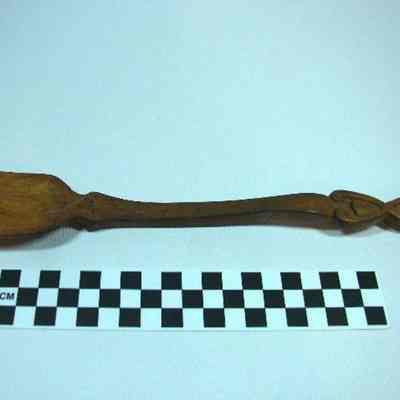

Spoon
Name/Title
Spoon
Description
Carved wooden spoon with double scrolls at head of handle.
Use
Possible indian use in St. Albans, Vermont
Acquisition
Source (if not Accessioned)
Abenaki Cultural Conservancy
Made/Created
Date made
circa 1900
Materials
Material
Wood
Entry/Object ID
L2024.3.39
Context
This is an equivocal piece; it is hand carved with a very distinct pair of double scrolls carved into the end of the handle. The curvature of the spoon is unlike most European derived designs. It will require much more research including a determination of the wood to begin to figure this object out.
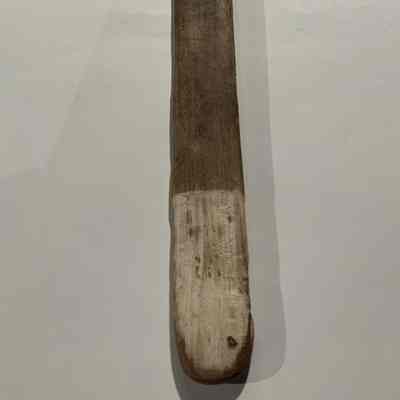

Stirrer
Name/Title
Stirrer
Description
Wooden stirring stick
Use
Used for stirring hominy, shows lye damage
Acquisition
Source (if not Accessioned)
Abenaki Cultural Conservancy
Made/Created
Date made
circa 1850
Entry/Object ID
L2024.3.42
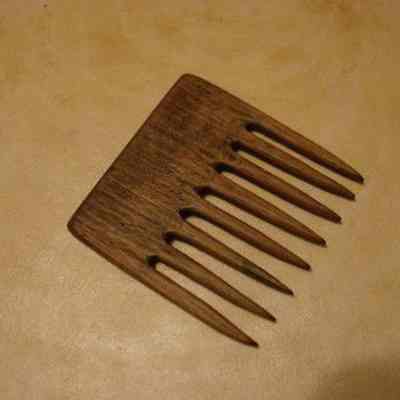

Sweetgrass Comb
Name/Title
Sweetgrass Comb
Description
Wooden comb with eight tines
Use
Processing sweetgrass for baskets
Acquisition
Source (if not Accessioned)
Abenaki Cultural Conservancy
Made/Created
Date made
circa 1900
Entry/Object ID
L2024.3.17
Context
A sweetgrass comb is easily distinguished from the very similar sheep wool comb used to extract burs and other large objects from shorn sheep wool. The lanolin in the sheep wool permeates those combs and creates a slippery dark coating to the tines. This piece from Northwest Central Vermont has no evidence of lanolin and presumably was used for other things, such as straightening and aligning hanks of sweetgrass before braiding or tying it for making baskets.